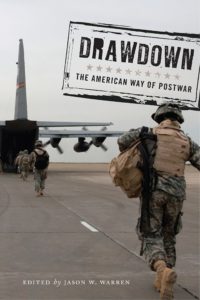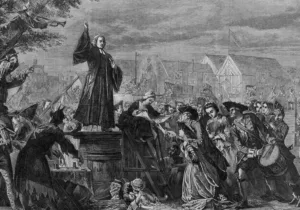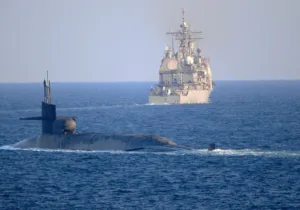“The shrinking of the armed forces is not just an economic necessity but a historical inevitability;” thus opens Drawdown: The American Way of Postwar, a fascinating analysis not of how the U.S. fights wars, but what it does in their aftermath. Military historian and Iraq War veteran Peter Mansoor opens the volume by asserting that however much Americans might support their troops (or at least claim to), the reality is that once warfighting ends the hard realities of budgets and public opinion will demand a contraction in the size of the armed forces.[i]
Historically, he is absolutely right—from the earliest years of colonization through 1945 Americans saw sizable armies as a threat to liberty, not the noble guardians of it. After every major war there followed a large-scale discharge of volunteers and draftees and the imposition of tight budgetary constraints on the military.
 Drawdown analyzes the history of this process in the U.S. Army. In a series of essays authored by some of the leading scholars in military history, Drawdown provides a survey of how the Army confronted postwar reductions and prepared itself for future wars. Despite a scathing epilogue that emphasizes a history of short-sighted cutbacks, the overall picture that emerges is one of an army that consistently manages to rise up and meet the challenges of the next conflict, and the reader cannot escape the conclusion that it is in fact possible to manage drawdowns well—indeed, the U.S. has done so on multiple occasions.
Drawdown analyzes the history of this process in the U.S. Army. In a series of essays authored by some of the leading scholars in military history, Drawdown provides a survey of how the Army confronted postwar reductions and prepared itself for future wars. Despite a scathing epilogue that emphasizes a history of short-sighted cutbacks, the overall picture that emerges is one of an army that consistently manages to rise up and meet the challenges of the next conflict, and the reader cannot escape the conclusion that it is in fact possible to manage drawdowns well—indeed, the U.S. has done so on multiple occasions.
Drawdown is quite clearly intended to speak to contemporary problems. In his epilogue, retired Army colonel Kevin W. Farrell comments on the “inevitable drawdown” facing the Army now that the occupation of Iraq is over and the war in Afghanistan ostensibly winding down. This is a far-from-certain proposition. Farrell wrote the epilogue in the aftermath of a 2015 announcement that the Army was cutting some 40,000 troops, and in 2016 an Army Times headline ominously warned that its forces were shrinking to pre-World War II levels.[ii] The political situation has changed significantly in the interim.[iii] The Trump Administration is now looking to give the military a sizable increase in its budget, and given the unstable situation in Afghanistan, American forces will likely remain there for the foreseeable future. Even beyond the wars in Afghanistan and Iraq, ongoing tensions in North Korea and a raging civil war in Syria make it unlikely the U.S. military is facing a serious reduction anytime soon.
That does not mean readers should pass over Drawdown, however, for it still offers superb insights into what has historically made the U.S. Army so effective, even when it had to rebuild itself at the outset of every war. Sheer numbers have value (just ask the German soldiers who invaded the Soviet Union), but the United States is unlikely to possess any such advantage if another conventional war arises in Asia or Eastern Europe. Even where it does have a numerical advantage, the American people will never support the wanton risking of the nation’s soldiers, nor should they. In Drawdown, we see the tools that make the U.S. military the envy of the world: intellectual development of the officer corps; understanding of the role, and limits, of technology; and clear perception of the kinds of challenges the Army will face in the future.[iv] Although far from perfect, the Army has a laudable track record developing these facets in peacetime, regardless of the size of the force, and it has paid off handsomely when war comes.
While postwar drawdowns historically gutted the enlisted ranks, the officer corps remained more stable. In the aftermath of every war, a cadre of career officers remained behind to plan and prepare for the next conflict. As early as the Jefferson Administration, the Army grew into a professional force and built up the educational apparatus at West Point to insure that, when wartime expansion came, those at the top of the chain-of-command would be competent, dedicated leaders capable of forming an effective strategy. This tradition remained even as the nature of the Army and of warfare in general changed. Crucially, during the much maligned interwar years prior to the Second World War, students at the Army War College gave rigorous study to the previous global war, making them uniquely prepared to meet the challenges of the next. It was, in part, this careful analysis by the rising generation of officers that made the interwar years an “unlikely success story” rather than the dismal failure that many historians depict.
If the years leading up to World War II were an unlikely success, the years leading up to World War I were a predictable failure, not only because of lax intellectual output by the officer corps, but because of woeful adaptation to new technology. In particular, the Army badly underestimated the way the airplane would change warfare, and upon entering the conflict the Army Air Corps lagged well behind its European counterparts. Today, the service risks making the opposite mistake—while the United States’ technological advantage over every other nation is indeed substantial, the experience of post-Cold War combat, and especially counterinsurgency, demonstrates that technology can never serve as a complete substitute for soldiers.
Even in the colonial era, success in war hinged on the experience and expertise gleaned from prior combat. In the Pequot War, battle-tested veterans from Europe’s Thirty Years War gave Connecticut the tactics and planning necessary to achieve success over Native American foes, and forty years later the veterans of that war played a crucial role in King Phillips War/Great Narragansett War. That tradition of military experience feeding military success continued throughout American history, but it is also true that the Army was usually only as effective as its understanding of, and preparation for, its mission allowed. Martin Clemis argues that the army that went into Vietnam was the “best-trained, best-equipped, most combat effective, and most operationally-competent Army” that the United States had ever fielded.[v] Hurling such a force against the enemy for well over a decade failed, however, to avert disaster in what was, at the time, America’s longest war. In the First Persian Gulf War, the Army was again extraordinarily well-equipped and well-trained, but it was also engaged in its ideal mission: a conventional ground war. Furthermore, the post-Vietnam rehabilitation of the Army occurred as it shifted its emphasis to conventional deterrence—the mission it was best suited for and had enjoyed sustained success at. In short, the success story that followed Vietnam involved not only the Army’s internal reforms, but a change in how the U.S. government used the Army and what expectations successive administrations placed on it.
Antulio Echevarria’s chapter on the Army from Vietnam to Desert Storm drives home this point, noting not only that the Army was able to focus on its preferred missions, but that it was able to convince policymakers to do likewise; while it “cannot opt to only carry out specific kinds of missions, it can shape its missions, and it can shape policymakers’ expectations about any mission.”[vi] Here Echevarria touches on a topic that is (surprisingly) lightly covered in the rest of the study: civil-military relations. Whatever size and budget the Army has is not given to it in a vacuum, but is the product of a complex negotiation between the branches of the armed forces, Congress, the president, and the American public. More mention of the state of civil-military relations at the end of conflicts, and of the crucial factor of inter-service rivalry would have given a fuller picture of how the size of the postwar Army has historically been established.
That said, this is an enormously valuable resource. The nature of the U.S. Army has undergone dramatic changes in the second half of the twentieth century, but the core elements of what makes it an effective fighting force remain the same. Regardless of what happens with the Army’s size and budget under the Trump Administration, it will still need to form realistic projections on the nation’s future security needs and how to make the best use of emerging technologies. It will need a skilled cohort of thoughtful, highly-educated officers to do both, as well as to lead soldiers into combat. A bottomless budget would not, in and of itself, solve the problem of balancing vital missions of counterinsurgency with conventional deterrence, nor will the U.S. ever be able to challenge a rising China on manpower and materiel alone. The challenges of the twenty-first century Army (and Navy, and Air Force) will require innovative thinking by the officer corps and careful consideration of how to focus resources towards clearly-defined aims. Readers of this volume will be pleased to learn that the service has a long, largely successful history of doing precisely that.
—
Thomas Sheppard holds a PhD in military history from the University of North Carolina. He lives in Washington DC, where he writes on history, foreign policy, and national security issues.
Photo Credit: Soldiers and Airmen from Provincial Reconstruction Team Zabul return to base after a quality assurance, quality control patrol near the city of Qalat, Zabul Province, Afghanistan, Nov. 1, 2010. U.S. Air Force photo/Staff Sgt. Brian Ferguson.
[i] Drawdown, ix
[ii] Jim Tice, “Army shrinks to smallest level since before World War II,” Army Times May 7, 2016.
[iii] “Army is Hiring: Army increases end strength by 28,000 soldiers,” U.S. Army, March 20, 2017
[iv] Drawdown, 19
[v] Drawdown, 232
[vi] Drawdown, 253-254







 Sponsor a student for Christianity & National Security 2024
Sponsor a student for Christianity & National Security 2024